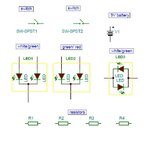Garetek
Newbie level 5
Good afternoon,
I am attempting to build a LED Circuit that is more complex that I know how to do. It runs off of a 9 volt battery and 3 LED's.
First off the Math
Battery 9 volt
3mm Red/Green LED
Red: 1.9-2.5 Volts @ 20ma
Green: 2.9-3.5 Volts @ 20ma
5mm White/Green LED
White:2.5-3.3 Volts @ 25ma
Green: 2.9-3.5 Volts @ 25ma
(White LED x2+Green3mm LED) 2.9+2.9+2.9=8.7 Running all three LEDS at 2.9 Volts.
(Green LED x2+Red LED)2.9+2.9+2.5=8.3 volts. Running the two green at 2.9
Resistors
(White LED x2+Green3mm LED) 9-8.7= .3 / .020(max milliamp rated for the smaller 3mm light)= 15 omhs
(White LED x2+Green3mm LED) 9-8.7= .3 *.020(max milliamp rated for the smaller 3mm light)= .006 watts
(Green LED x2+Red LED) 9-8.3= .7 / .020(max milliamp rated for the smaller 3mm light)= 35 Omhs
(Green LED x2+Red LED) 9-8.3= .7 * .020(max milliamp rated for the smaller 3mm light)= .014 watts
Now the tricky part, how to wire it all together.
Below is a LED Diagram that I made feel free to tell me its wrong, but any help would be greatly appreciated.

5 represents the switch that will hopefully turn off one set of colors and on the other set.(Green&Red-White&Green)
6 represents the main on off switch for the device.
I am attempting to build a LED Circuit that is more complex that I know how to do. It runs off of a 9 volt battery and 3 LED's.
First off the Math
Battery 9 volt
3mm Red/Green LED
Red: 1.9-2.5 Volts @ 20ma
Green: 2.9-3.5 Volts @ 20ma
5mm White/Green LED
White:2.5-3.3 Volts @ 25ma
Green: 2.9-3.5 Volts @ 25ma
(White LED x2+Green3mm LED) 2.9+2.9+2.9=8.7 Running all three LEDS at 2.9 Volts.
(Green LED x2+Red LED)2.9+2.9+2.5=8.3 volts. Running the two green at 2.9
Resistors
(White LED x2+Green3mm LED) 9-8.7= .3 / .020(max milliamp rated for the smaller 3mm light)= 15 omhs
(White LED x2+Green3mm LED) 9-8.7= .3 *.020(max milliamp rated for the smaller 3mm light)= .006 watts
(Green LED x2+Red LED) 9-8.3= .7 / .020(max milliamp rated for the smaller 3mm light)= 35 Omhs
(Green LED x2+Red LED) 9-8.3= .7 * .020(max milliamp rated for the smaller 3mm light)= .014 watts
Now the tricky part, how to wire it all together.
Below is a LED Diagram that I made feel free to tell me its wrong, but any help would be greatly appreciated.

5 represents the switch that will hopefully turn off one set of colors and on the other set.(Green&Red-White&Green)
6 represents the main on off switch for the device.



